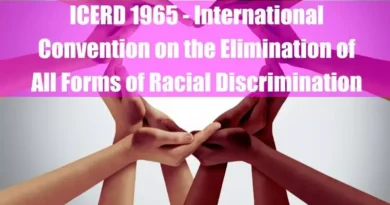ILO Conventions on Harassment & Discrimination
Introduction
Overview of ILO’s Role in Setting International Labor Standards
The International Labour Organization (ILO) is a specialized agency of the United Nations that has been instrumental in establishing international labor standards. Founded in 1919, the ILO’s mandate is to promote social justice and internationally recognized human and labor rights.
It brings together governments, employers, and workers from its member states to develop policies and programs that foster decent work conditions.
The ILO’s conventions, recommendations, and protocols serve as the primary tools to achieve these goals, creating a framework for governments worldwide to adopt and implement national laws that protect workers’ rights and promote fair labor practices.
Brief History and Significance of Conventions Addressing Harassment and Discrimination
The ILO’s involvement in tackling harassment and discrimination began as global awareness of these issues increased. Convention No. 111, adopted in 1958, was among the first to explicitly address discrimination in employment and occupation.
Over the years, as workplace challenges evolved, so did the ILO’s approach. The adoption of Convention No. 190 in 2019 marked a significant milestone as it addressed both violence and harassment in the workplace for the first time.
These conventions are critical in setting international benchmarks and guiding national efforts to eliminate discrimination and create safer, more inclusive workplaces.
Takeaways
| Key Points |
|---|
| ILO Convention No. 111 focuses on eliminating discrimination in employment and occupation based on race, sex, religion, and other factors, requiring member states to develop policies to ensure equal access to vocational training, fair treatment in hiring, and protection from workplace discrimination. |
| The convention has been applied across various sectors, with countries integrating it into national laws to protect workers in fields such as education and healthcare, while some industries have tailored approaches to address specific challenges. |
| Convention No. 190, addressing violence and harassment in the workplace, was adopted in 2019 after extensive consultations, defining violence and harassment broadly to include physical, psychological, sexual, and economic harm, and extending protections to all workers, including informal workers and volunteers. |
| Both conventions emphasize the importance of national legislation to enforce these standards, with countries required to implement laws that address discrimination, harassment, and violence, provide victim support, and create reporting and redress mechanisms. |
| The ratification of these conventions has led to significant policy shifts, promoting gender equality and inclusion, but challenges remain in fully realizing their objectives due to cultural, resource, and awareness barriers in some regions. |
Key ILO Conventions Related to Harassment and Discrimination
Convention No. 111 (Discrimination in Employment and Occupation)
Key Provisions and Scope
Convention No. 111 was adopted to combat discrimination in employment and occupation, covering areas such as race, color, sex, religion, political opinion, national extraction, and social origin.
The convention mandates that member states develop and pursue a national policy to eliminate employment and occupation discrimination. This includes ensuring equal access to vocational training, fair treatment in hiring and promotions, and protection against discriminatory practices in the workplace.
The broad scope of this convention allows it to be applied across various sectors, ensuring that all workers receive equal protection under the law.
Application Across Different Sectors and Regions
Implementing Convention No. 111 has seen varied applications across different sectors and regions. For example, in many countries, this convention has been integrated into national anti-discrimination laws, shaping policies that protect workers from unfair treatment in diverse sectors such as education, healthcare, and manufacturing.
In some regions, specific industries, like mining or textiles, have developed tailored approaches to address unique challenges related to discrimination, ensuring compliance with both the spirit and letter of the convention.

Convention No. 190 (Violence and Harassment Convention, 2019)
Background and Adoption Process
Convention No. 190 is a landmark treaty that addresses violence and harassment in the world of work. Its adoption was driven by global movements calling for stronger protections against workplace violence, particularly gender-based violence.
The convention was developed through a comprehensive consultation with governments, employers, and workers’ representatives. It was formally adopted at the ILO’s Centenary International Labour Conference in June 2019, reflecting a collective commitment to combating violence and harassment at work.
Definition of Violence and Harassment Under the Convention
The convention defines violence and harassment as behaviors, practices, or threats that result in physical, psychological, sexual, or economic harm. This broad definition encompasses a range of harmful actions, including physical abuse, verbal harassment, sexual harassment, bullying, and stalking.
The convention also recognizes that violence and harassment can occur both within and outside of the traditional workplace, including during work-related travel or through online communications.
Scope of Protection and Applicability
Convention No. 190 applies to all workers, regardless of their contractual status, and covers both the public and private sectors. It extends protections to informal workers, volunteers, job applicants, and even individuals exercising the authority of an employer.
The convention also takes into account the impact of domestic violence on the workplace, highlighting the need for supportive measures such as leave for victims and flexible working arrangements.
The comprehensive scope of this convention makes it a powerful tool for addressing a wide range of workplace violence and harassment issues globally.
Interpretation and Implementation of the Conventions
Guidelines for Member States to Implement Conventions
The ILO provides detailed guidelines to assist member states in implementing its conventions effectively. Convention No. 111 involves adopting national policies that promote employment and occupation equality and establishing enforcement mechanisms to address violations.
For Convention No. 190, member states are encouraged to develop national laws that explicitly prohibit violence and harassment in the workplace, along with preventive measures, victim support services, and robust enforcement procedures.

Role of National Legislation in Enforcing ILO Standards
National legislation is crucial in translating the principles of ILO conventions into actionable measures. For instance, countries that have ratified Convention No. 190 are expected to enact laws that not only prevent workplace violence and harassment but also provide clear avenues for reporting incidents and seeking redress.
These laws often require employers to conduct regular risk assessments, implement preventive measures, and establish clear procedures for addressing complaints.
Case Studies of Implementation in Different Countries
Several countries provide compelling examples of how ILO conventions have been implemented effectively. For example, in Australia, the ratification of Convention No. 190 has initiated significant legal reforms to enhance protections against workplace harassment, with ongoing efforts to establish comprehensive support services for victims.
In South Africa, Convention No. 111 has been integrated into the National Employment Equity Act, which mandates affirmative action and prohibits discrimination in hiring practices across all sectors.
Impact of ILO Conventions on Global Labor Practices
Changes in Workplace Policies and Cultures Post-Ratification
The ratification of ILO conventions on harassment and discrimination has spurred significant changes in workplace policies and cultures worldwide. Many organizations have adopted zero-tolerance policies towards harassment and discrimination, supported by training programs designed to raise awareness and change attitudes.
These shifts have contributed to more inclusive work environments where workers feel safer and more valued.
Influence on Gender Equality and Protection of Vulnerable Groups
The impact of ILO conventions is particularly evident in promoting gender equality. By addressing issues like sexual harassment and discrimination, these conventions have empowered women and other marginalized groups, leading to greater participation in the workforce and more equitable treatment.
This has been complemented by national policies that provide additional protections for vulnerable groups, ensuring that the benefits of these conventions are felt by all workers, regardless of their background.
Global Adoption Trends and Challenges in Implementation
While many countries have ratified these conventions and made significant strides in their implementation, challenges remain. Cultural and social barriers, limited resources, and lack of awareness hinder fully realizing the conventions’ objectives in some regions.
Nevertheless, the global trend towards greater adoption and enforcement of these standards reflects a growing recognition of the importance of addressing harassment and discrimination in the workplace.

Challenges and Criticisms
Common Challenges Faced by Countries in Ratifying and Implementing These Conventions
Countries often face several challenges in ratifying and implementing ILO conventions. These include legal and administrative hurdles, resistance from employers or other stakeholders, and the complexities of aligning national laws with international standards.
In some cases, economic concerns, such as the perceived cost of compliance, may delay or impede ratification and implementation efforts.
Criticisms Regarding the Scope and Effectiveness of the Conventions
Despite their significance, ILO conventions on harassment and discrimination have faced criticism regarding their scope and effectiveness.
Some stakeholders argue that the conventions do not address the specific needs of certain groups, such as informal workers or those in precarious employment situations. Others have pointed out that the conventions’ broad definitions of violence and harassment may lead to difficulties in enforcement, particularly in jurisdictions with limited legal resources.

Ongoing Debates and Areas for Improvement
There are ongoing debates about how to strengthen the impact of ILO conventions on harassment and discrimination.
Some suggest that additional protocols or amendments may be needed to address emerging issues, such as the rise of remote work and its implications for workplace harassment. Others advocate for greater international cooperation to ensure consistent enforcement and support for countries that may struggle with implementation.
The Role of Social Dialogue in Implementing ILO Standards
Importance of Tripartite Collaboration (Governments, Employers, Workers)
Social dialogue involving governments, employers, and workers is essential to successfully implement ILO standards. This tripartite approach ensures that the perspectives and interests of all stakeholders are considered, leading to more balanced and effective policies.
Through social dialogue, countries can develop consensus-based solutions that address the unique challenges of implementing ILO conventions in different contexts.
Examples of Successful Social Dialogue in the Context of ILO Conventions
Social dialogue has been crucial in implementing ILO conventions in several countries. For instance, in Finland, tripartite negotiations have contributed to developing workplace policies that, while not explicitly tied to Convention No. 190, include provisions that address workplace violence and harassment in line with ILO principles.
In other cases, social dialogue has facilitated the adoption of collective agreements that provide additional protections for workers beyond those mandated by national laws.
Future Directions and Developments
Upcoming Conventions or Amendments Related to Harassment and Discrimination
The ILO continues to explore new ways to enhance the effectiveness of its conventions on harassment and discrimination. This includes the potential development of new conventions or the amendment of existing ones to address emerging challenges. For example, future standards may focus on the digital workplace, considering the rise of remote work and the associated risks of online harassment.
Predictions for Future International Labor Standards
As the global workforce evolves, so will the ILO’s approach to labor standards. Future conventions may place greater emphasis on intersectionality, recognizing the overlapping and intersecting forms of discrimination that workers may face.
Additionally, there is likely to be a continued focus on strengthening enforcement mechanisms, ensuring that the rights enshrined in ILO conventions are fully realized in the workplace.
The Evolving Role of the ILO in Promoting Workplace Rights
The ILO’s role in promoting workplace rights will evolve as new challenges emerge. The organization is likely to place greater emphasis on intersectionality, recognizing how different forms of discrimination intersect and compound to create unique challenges for certain workers.
Additionally, as work environments change with technological advances and shifts in global labor markets, the ILO must adapt its standards to ensure they remain relevant and effective in protecting workers’ rights.
Conclusion
ILO conventions on harassment and discrimination are crucial in the global effort to promote equality and protect workers’ rights. These conventions have driven significant changes in national laws and workplace practices, fostering safer, more inclusive environments.
Despite challenges in implementation, the progress achieved so far underscores the importance of these standards in advancing social justice.
As the ILO continues to adapt to new challenges, its conventions on harassment and discrimination will remain central to its mission of promoting decent work for all.
FAQ
What is ILO Convention 190?
ILO Convention 190, known as the Violence and Harassment Convention, establishes comprehensive international standards to prevent and address violence and harassment in the workplace. It mandates the creation of safe work environments through robust preventive measures, effective complaint mechanisms, and support systems for affected workers.
What is ILO Convention 111?
ILO Convention 111, the Discrimination (Employment and Occupation) Convention, sets forth principles for eliminating discrimination in the workplace based on race, sex, religion, and other protected characteristics. It provides a legal framework to promote equal opportunities and fair treatment, ensuring inclusive practices in employment and occupation.
What defines workplace harassment under ILO standards?
Under ILO standards, workplace harassment is defined as any unwelcome behavior that undermines an individual’s dignity and creates a hostile or intimidating work environment. The framework emphasizes clear policies, preventive actions, and accessible complaint and remedial procedures to protect workers’ rights and well-being.
What constitutes sexual harassment in ILO Conventions?
Unwelcome sexual advances characterize sexual harassment in ILO Conventions or conduct that interferes with an individual’s work performance or creates a hostile work environment. The conventions require employers to implement preventative measures, provide support for victims, and ensure fair investigation and redressal processes.
What is workplace violence per ILO Conventions?
Workplace violence, as defined by ILO Conventions, includes any act or threat of physical violence, intimidation, or other harmful behavior occurring at work. It obliges employers to conduct risk assessments, establish preventive strategies, and provide necessary support and remedies for affected employees.
What is direct discrimination in ILO terms?
Direct discrimination occurs when an individual is treated less favorably than others in an equivalent situation solely because of a protected characteristic, according to ILO definitions. This principle underlines the commitment to equal treatment in the workplace and supports the enforcement of legal remedies to counteract such practices.
What is indirect discrimination as per ILO standards?
Indirect discrimination refers to policies or practices that appear neutral but disproportionately disadvantage a specific group based on protected characteristics, as recognized by ILO standards. The approach calls for carefully evaluating and modifying workplace policies to ensure that they do not unintentionally perpetuate inequality.
What is equal treatment in ILO conventions?
Equal treatment in ILO conventions ensures that all employees receive unbiased and fair treatment in every aspect of employment, from hiring to daily workplace interactions. This principle is integral to fostering an inclusive work environment and is supported by legal obligations designed to prevent discrimination and harassment.
What is equal remuneration under ILO standards?
As set out in ILO standards, equal remuneration mandates that individuals performing work of equal value should receive the same pay level regardless of gender or other discriminatory factors. This concept is crucial for promoting fairness and reducing wage disparities in the workplace.
What does due process mean in workplace investigations?
Due process in workplace investigations involves a fair, transparent, and impartial procedure for addressing allegations of harassment and discrimination. It guarantees that all parties involved are given the opportunity to present evidence and be heard, ensuring that outcomes are based on objective criteria and legal standards.
What are internal complaint mechanisms per ILO guidelines?
Internal complaint mechanisms are structured procedures established within organizations to allow employees to report incidents of harassment or discrimination confidentially and safely. These mechanisms are designed to facilitate early resolution, ensure impartial investigations, and implement timely remedial actions to uphold a respectful work environment.
What is the remedial action framework in ILO Conventions?
The remedial action framework in ILO Conventions outlines the processes and measures to address and correct instances of harassment and discrimination once they occur. It includes provisions for support, compensation, and corrective measures aimed at restoring the dignity of affected individuals while deterring future violations.
What are preventive measures in ILO frameworks?
Preventive measures in ILO frameworks refer to proactive policies and practices implemented to stop harassment and discrimination before they occur. These measures include risk assessments, employee training, establishing clear codes of conduct, and creating safe channels for reporting concerns.
What are investigative procedures in the ILO context?
Investigative procedures in the ILO context involve systematic and impartial methods for examining allegations of harassment and discrimination within the workplace. These procedures ensure that evidence is collected fairly and confidentially, supporting informed decisions that uphold the rights of both the complainant and the accused.
What is employer accountability as defined by ILO?
Employer accountability, as defined by ILO Conventions, is the responsibility of employers to ensure compliance with legal standards and actively foster a safe, respectful work environment. This accountability encompasses implementing effective policies, conducting regular training, and establishing monitoring and remedial mechanisms to address any breaches of conduct.









